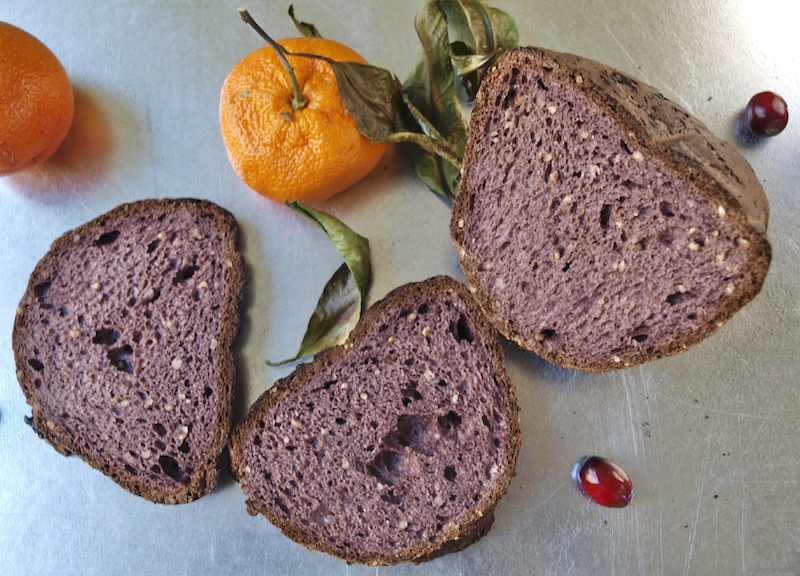
This attractive, unusual bread gets its dark lilac hue from fresh-ground black rice flour. Leavened with quinoa sourdough starter and shaped into a fat hemisphere, it's tasty, rich and very slow-to stale. The solid crumb makes for easy slicing as thin or thick as you want, and the loaf is big enough to yield full-size sandwiches
Yield: one, 16-ounce sourdough Boule - enough bread for two adults to enjoy for three days.
Time to make: 45 minutes active. 10 hour proof. 1 hour 40 minutes oven time.
Equipment needed: Stand mixer with paddle blade. Measuring cups and spoons, or kitchen scale. Silicone spatula. 2 sheets bakers parchment. Household stapler.
Ingredients
Note:
Use a grain grinder to produce black rice flour from black "Temple" or "Forbidden" rice, and buckwheat meal from un-roasted buckwheat groats. Grinders may be stone, blade or burr, powered or hand-driven.
Procedure:
1) Place black rice into a grain grinder set to its finest setting. Grind until all the grains have been reduced to flour. Note: with some grinders it may be necessary to perform two steps, first to a medium and then to a fine texture. Use the same grinder, set to "coarse", to grind the buckwheat groats into meal.
2) Place the following into the bowl of a stand mixer: The potato starch, the tapioca starch, the rice flour, the oat flour, the steel-cut oats, the buckwheat meal, the xanthan gum and the salt. Stir on low speed until thoroughly mixed.
3) Measure the water into a medium bowl. Add the sleeping leaven and stir until thoroughly integrated. Add to the stand mixer and mix on medium-low until all ingredients are wet - about 1 minute. Allow dough to rest 2 - 5 minutes, then beat again on medium-high until dough just barely begins to cling to bowl edges, about 1 minute.
4) Turn dough out onto a sheet of bakers parchment, placing dough in the middle of the sheet. Use a wet, frequently-dipped silicone spatula to shape dough into a sphere. Smooth surface as much as you are able. (For a speeded-up video of dough shaping and smoothing, click HERE). Invert a large bowl or the bowl of the stand mixer over the loaf to retain moisture. Proof for 10 - 11 hours at room temperature, about 70 F, or until the dough becomes swollen and slightly wiggly. It may also develop deep crevasses. It will not double in size.
5) Position an oven rack in the center slot. Heat oven to 425 F. Staple a second sheet of bakers parchment over the sheet on which the dough has risen. Place this "package" directly on the oven rack. Bake for 30 minutes, then carefully cut parchment parcel open, exposing loaf. Remove and discard parchment. Bake bread an additional 70 minutes. Remove to a cooling rack and allow to cool completely - at least 4 hours - before cutting and serving.
Bread may be stored, uncovered, at room temperature, or frozen. DO NOT refrigerate. Cut bread may be placed cut-side-down on a board or counter. Do not cover. Remains fresh a minimum of 3 days.
